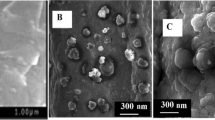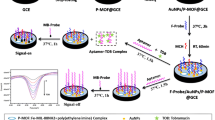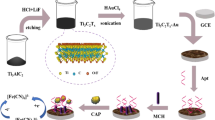Abstract
Rapid, accurate, sensitive, and real-time detection of streptomycin (STR) residues in dairy products is very important. In this work, for the first time, the gold nanoflower/polyethyleneimine-functionalized metal organic framework (AuNF-PEI-MIL-101(Cr)) nanocomposites were synthesized via hydrothermal method and characterized using various techniques (SEM, TEM, XRD, FT-IR, and XPS). Then, a novel electrochemical aptasensor was constructed for the detection of STR based on AuNF-PEI-MIL-101(Cr) nanocomposites. The gold electrode (GE) modified with AuNF-PEI-MIL-101(Cr) can immobilize a large number of thiolated STR aptamer via the Au–S bond. When the target STR was in the presence, the current signal was reduced due to the specific binding of STR towards the aptamer. The results indicated that the aptasensor had a wide linear range towards STR (0.01–400 nM) with a low detection limit of 0.003 nM under the optimal conditions. Moreover, the aptasensor exhibited good selectivity, reproducibility, and stability. In addition, the STR in the cow, sheep, and goat milk samples was detected by the spiked recovery method, and satisfactory results were obtained. The method provides an efficient pathway for the sensitive detection of STR.






Similar content being viewed by others
Data Availability
The authors declare that the data supporting the findings of this study are available within the article.
References
Amouzadeh Tabrizi M, Acedo P (2022) An electrochemical immunosensor for the determination of procalcitonin using the gold-graphene interdigitated electrode. Biosensors 12(10):771. https://doi.org/10.3390/bios12100771
Bayazit S, Yildiz M, Aşçi Y, Şahin M, Bener M, Eğlence S, Salam M (2017) Rapid adsorptive removal of naphthalene from water using graphene nanoplatelet/MIL-101 (Cr) nanocomposite. J Alloy Compd 701:740–749. https://doi.org/10.1016/j.jallcom.2017.01.111
Biswas S, Lan Q, **e Y, Sun X, Wang Y (2021) Label-free electrochemical immunosensor for ultrasensitive detection of carbohydrate antigen 125 based on antibody-immobilized biocompatible mof-808/cnt. ACS Appl Mater Inter 13(2):3295–3302. https://doi.org/10.1021/acsami.0c14946
Chen B, Zhang H, Lin B, Ge J, Qiu L (2012) Determination of streptomycin residue in cucumber and chinese cabbage by high-performance liquid chromatography with postcolumn derivatization and fluorometric detection. J Aoac Int 95:523–527. https://doi.org/10.5740/jaoacint.10-316
Chen Y, Liu Z, Guo L, Cao J, Zhou J, Zuo J, Bai L (2019) A sandwich-type electrochemical aptasensor for Mycobacterium tuberculosis MPT64 antigen detection using C60NPs decorated N-CNTs/GO nanocomposite coupled with conductive PEI-functionalized metal-organic framework. Biomaterials 216:119253. https://doi.org/10.1016/j.biomaterials.2019.119253
Cheng M, Lai C, Liu Y, Zeng G, Huang D, Zhang C, Qin L, Hu L, Zhou C, **ong W (2018) Metal-organic frameworks for highly efficient heterogeneous Fenton-like catalysis. Coordin Chem Rev 368:80–92. https://doi.org/10.1016/j.ccr.2018.04.012
Cheng Y, Barpaga D, Soltis J, Shutthanandan V, Chatterjee S (2020) Metal-organic framework based microfluidic impedance sensor platform for ultrasensitive detection of perfluorooctanesulfonate. ACS Appl Mater Inter 12:10503–10514. https://doi.org/10.1021/acsami.9b22445
De Carvalho RC, Betts AJ, Cassidy JF (2020) Diclofenac determination using CeO2 nanoparticle modified screen-printed electrodes – a study of background correction. Microchem J 158:105258. https://doi.org/10.1016/j.microc.2020.105258
Duan Y, Wang N, Huang Z, Dai H, Xu L, Sun S, Ma H, Lin M (2019) Electrochemical endotoxin aptasensor based on a metal-organic framework labeled analytical platform. Mat Sci Eng C-Mater 108:110501. https://doi.org/10.1016/j.msec.2019.110501
Gzde A, Pekyardmc U (2020) An electrochemical sandwich-type aptasensor for determination of lipocalin-2 based on graphene oxide/polymer composite and gold nanoparticles - sciencedirect. Talanta 210:120666. https://doi.org/10.1016/j.talanta.2019.120666
Hai G, Wang H (2022) Theoretical studies of metal-organic frameworks: calculation methods and applications in catalysis, gas separation, and energy storage. Coordin Chem Rev 469:214670. https://doi.org/10.1016/j.ccr.2022.214670
He B, Wang S (2021) An electrochemical aptasensor based on PEI-C3N4/AuNWs for determination of chloramphenicol via exonuclease-assisted signal amplification. Microchim Acta 188:22
Ho T, Chan C, Chan KH, Wang Y, Lin J, Chang C, Chang C (2013) Development of a novel bead-based 96-well filtration plate competitive immunoassay for the detection of gentamycin. Biosens Bioelectron 49(15):126–132. https://doi.org/10.1016/j.bios.2013.04.027
Huang Q, Lin X, Chen D, Tong X (2022) Carbon dots/alpha-Fe2O3-Fe3O4 nanocomposite: Efficient synthesis and application as a novel electrochemical aptasensor for the ultrasensitive determination of aflatoxin B1. Food Chem 373:131145. https://doi.org/10.1016/j.foodchem.2021.131415
Hui Y, Peng H, Zhang F, Zhang L, Liu Y, Zhao A, Jia R, Wang B, Song Y (2022) A novel electrochemical aptasensor based on layer-by-layer assembly of DNA-Au@Ag conjugates for rapid detection of aflatoxin M1 in milk samples. J Dairy Sci 105(3):1966–1977. https://doi.org/10.3168/jds.2021-20931
Kaufmann A, Butcher P, Maden K (2012) Determination of aminoglycoside residues by liquid chromatography and tandem mass spectrometry in a variety of matrices. Anal Chim Acta 711:46–53. https://doi.org/10.1016/j.aca.2011.10.042
Lu Q, Zhang J, Liu X, Wu Y, Yuan R, Chen S (2014) Enhanced electrochemiluminescence sensor for detecting dopamine based on gold nanoflower@graphitic carbon nitride polymer nanosheet-polyaniline hybrids. Analyst 139(24):6556–6562. https://doi.org/10.1039/c4an01595a
Lu M, Deng Y, Yi L, Lv J, Wang J (2018) Graphene aerogelmetal-organic framework-based electrochemical method for simultaneous detection of multiple heavy metal ions. Anal Chem 91(1):888–895. https://doi.org/10.1021/acs.analchem.8b03764
Luo Y, Tian X, Yong D, Chen Q, Huang Y, Feng D, Ai C, Mi Y (2020) A photoelectrochemical aptasensor for the sensitive detection of streptomycin based on a TiO2/BiOi/BioBr heterostructure. Anal Chim Acta 1115:33–40. https://doi.org/10.1016/j.aca.2020.04.021
Mehmandoust M, Erk N, Naser M, Soylak M (2023) Molecularly imprinted polymer film loaded on the metal–organic framework with improved performance using stabilized gold-doped graphite carbon nitride nanosheets for the single-step detection of Fenamiphos. Food Chem 404:134627. https://doi.org/10.1016/j.foodchem.2022.134627
Meng X, Gu H, Yi H, He Y, Chen Y, Sun W (2020) Sensitive detection of streptomycin in milk using a hybrid signal enhancement strategy of MOF-based bio-bar code and target recycling. Anal Chim Acta 1125:1–7. https://doi.org/10.1016/j.aca.2020.05.041
Pourreza A, Askari S, Rashidi A, Seif A, Kooti M (2019) Highly efficient so3 ag-functionalized mil-101(Cr) for adsorptive desulfurization of the gas stream: experimental and dft study. Chem Eng J 363:73. https://doi.org/10.1016/j.cej.2019.01.133
Shen C, Wu S, Meng Q (2021) Construction of portable drinking water device using an agricultural biomass-derived material of polyethylenimine-grafted-corncob. Food Control 130:108375
Sun R, Lv R, Li Y, Du T, Chen L, Zhang Y, Zhang X, Zhang L, Ma H, Sun H, Qi Y (2023) Simple and sensitive electrochemical detection of sunset yellow and Sudan I in food based on AuNPs/Zr-MOF-Graphene. Food Control 145:109491. https://doi.org/10.1016/j.foodcont.2022.109491
Suresh K, Matzger AJ (2019) Enhanced drug delivery by dissolution of amorphous drug encapsulated in a water unstable metal–organic framework (mof). Angew Chem Int Edit 58(47):16790–16794. https://doi.org/10.1002/anie.201907652
Taghdisi S, Danesh N, Nameghi M, Ramezani M, Abnous K (2016) A label-free fluorescent aptasensor for selective and sensitive detection of streptomycin in milk and blood serum. Food Chem 203:145–149. https://doi.org/10.1016/j.foodchem.2016.02.017
Thakur H, Kaur N, Sareen D, Prabhakar N (2017) Electrochemical determination of m. tuberculosis antigen based on poly(3,4-ethylenedioxythiophene) and functionalized carbon nanotubes hybrid platform. Talanta 171:115–123. https://doi.org/10.1016/j.foodchem.2016.02.017
Vanbruijnsvoort M, Ottink S, Jonker K, Deboer E (2004) Determination of streptomycin and dihydrostreptomycin in milk and honey by liquid chromatography with tandem mass spectrometry. J Chromatogr A 1058(1–2):137–142. https://doi.org/10.1016/j.chroma.2004.07.101
Villalonga A, Sánchez A, Vilela D, Mayol B, Martínez-Ruíz P, Villalonga R (2022) Electrochemical aptasensor based on anisotropically modified (Janus-type) gold nanoparticles for determination of C-reactive protein. Microchim Acta 189(8):309. https://doi.org/10.1007/s00604-022-05420-4
Wan J, Li Y, Jiang Y, Lin L, Yin Y (2021) Silver-doped MIL-101(Cr) for rapid and effective capture of iodide in water environment: exploration on adsorption mechanism. J Radioanal Nucl Ch 328:1041–1054. https://doi.org/10.1016/j.chroma.2004.07.101
Wang Y, Wang L, Chen H, Hu X, Ma S (2016) Fabrication of highly sensitive and stable hydroxylamine electrochemical sensor based on gold nanoparticles and metal–metalloporphyrin framework modified electrode. ACS Appl Mater Inter 8(28):18173–18181. https://doi.org/10.1021/acsami.6b04819
**n Q, Ouyang J, Liu T, Li Z, Li Z, Liu Y, Wang S, Wu H, Jiang Z, Cao X (2015) Enhanced interfacial interaction and co2 separation performance of mixed matrix membrane by incorporating polyethylenimine-decorated metal-organic frameworks. ACS Appl Mater Inter 7(2):1065–1077. https://doi.org/10.1021/am504742q
Yao J, Yue T, Huang C, Wang H (2021) A magnified aptamer fluorescence sensor based on the metal organic frameworks adsorbed dna with enzyme catalysis amplification for ultra-sensitive determination of atp and its logic gate operation. Bioorg Chem 114:105020. https://doi.org/10.1016/j.bioorg.2021.105020
Yin J, Guo W, Qin X, Zhao J, Pei M, Ding F (2017) A sensitive electrochemical aptasensor for highly specific detection of streptomycin based on the porous carbon nanorods and multifunctional graphene nanocomposites for signal amplification. Sensor Actuat B-Chem 241:151–159. https://doi.org/10.1016/j.snb.2016.10.062
Yuan N, Gong X, Han B (2021) Hydrophobic fluorous metal-organic framework nanoadsorbent for removal of hazardous wastes from water. ACS Appl Nano Mater 4(2):1576–1585. https://doi.org/10.1021/acsanm.0c03050
Zhang L, Wang G, **ong C, Zheng L, He J, Ding Y, Lu H, Zhang G, Cho K, Qiu L (2018a) Chirality detection of amino acid enantiomers by organic electrochemical transistor. Biosens Bioelectron 105:121–128. https://doi.org/10.1016/j.bios.2018.01.035
Zhang S, Piepers S, Shan R, Cai L, Mao S, Zou J, Ali T, De Vliegher S, Han B (2018b) Phenotypic and genotypic characterization of antimicrobial resistance profiles in streptococcus dysgalactiae isolated from bovine clinical mastitis in 5 provinces of China. J Dairy Sci 101:3344–3355. https://doi.org/10.3168/jds.2017-14031
Zhang F, Niu T, Wu F, Wu L, Wang G, Li J (2021) Highly oriented MIL-101(Cr) continuous films grown on carbon cloth as efficient polysulfide barrier for lithium-sulfur batteries. Electrochim Acta 392:139028. https://doi.org/10.1016/j.electacta.2021.139028
Zhao W, Wei J, Sun M, Liu X, Zhang Q, Zong C et al (2016) Colorimetric detection of Cu2+ by surface coordination complexes of polyethyleneimine-capped au nanoparticles. Sensor Actuat B-Chem 223(411–416):411–416. https://doi.org/10.1016/j.snb.2015.09.119
Zhou N, Wang J, Zhang J, Li C, Tian Y, Wang J (2013) Selection and identification of streptomycin-specific single-stranded dna aptamers and the application in the detection of streptomycin in honey. Talanta 108:109–116. https://doi.org/10.1016/j.talanta.2013.01.064
Zhou Y, Huang X, Zhang W, Ji Y, Chen R, **ong Y (2017) Multi-branched gold nanoflower-embedded iron porphyrin for colorimetric immunosensor. Biosens Bioelectron 102:9–16. https://doi.org/10.1016/j.bios.2017.10.046
Zhu Q, Li H, Sun X, Han Z, Sun J, He H (2021) Rational incorporation of covalent organic framework/carbon nanotube (COF/CNT) composites for electrochemical aptasensing of ultra-trace atrazine. J Mater Chem A 9(25):8043–8050
European Commission (2010) Commission regulation (EU) No 37/2010 of December 2009 on pharmacologically active substances and their classification regarding maximum residue limits in foodstuffs of animal origin.
Mehmandoust M, Erk E E, Soylak M, Erk N, Karimi F (2022) Metal–organic framework based electrochemical immunosensor for label-free detection of glial fibrillary acidic protein as a biomarker. Ind Eng Chem Res acs.iecr.2c01445. https://doi.org/10.1021/acs.iecr.2c01445
Funding
This study was supported by the Science and Technology Program of **’an City (20NYYF0018) and the Supported by the Fundamental Research Funds for the Central Universities (2021CBLY007).
Author information
Authors and Affiliations
Contributions
All authors contributed to the study conception and design. Yuanyuan Hui wrote the main manuscript. Material preparation, data collection, and analysis were performed by Yuanyuan Hui, Haishuai Peng, Ding Yang, and Weizhe Wang. Linqiang Li, Aiqing Zhao, and Bini Wang revised it critically for important intellectual content. Bini Wang provided financial support. All authors read and approved the final manuscript.
Corresponding author
Ethics declarations
Competing interests
The authors declare no competing interests.
Ethics Approval
This article does not contain any studies with human participants or animals performed by any of the authors.
Conflict of Interest
Yuanyuan Hui declares that he has no conflict. Haishuai Peng declares that he has no conflict of interest. Linqiang Li declares that he has no conflict of interest. Aiqing Zhao declares that he has no conflict of interest. Ding Yang declares that he has no conflict of interest. Weizhe Wang declares that he has no conflict of interest. Bini Wang declares that he has no conflict of interest.
Additional information
Publisher's Note
Springer Nature remains neutral with regard to jurisdictional claims in published maps and institutional affiliations.
Highlights
1. The presence of AuNF-PEI-MIL-101(Cr) on the sensor surface increases the aptamer loading efficiency.
2. The developed aptasensor exhibits wide linear range and low detection limit for streptomycin.
3. The aptasensor shows high sensitivity and selectivity.
4. Fabricated aptasensor can be proposed for monitoring other antibiotics in foodstuffs.
Supplementary Information
Below is the link to the electronic supplementary material.
Rights and permissions
Springer Nature or its licensor (e.g. a society or other partner) holds exclusive rights to this article under a publishing agreement with the author(s) or other rightsholder(s); author self-archiving of the accepted manuscript version of this article is solely governed by the terms of such publishing agreement and applicable law.
About this article
Cite this article
Hui, Y., Peng, H., Li, L. et al. A Sensitive and Selective Electrochemical Aptasensor Based On Gold Nanoflower/Polyethyleneimine (Pei)-Functionalized Metal Organic Framework Nanocomposites for Label-Free Determination of Streptomycin in Milk Samples. Food Anal. Methods 16, 677–688 (2023). https://doi.org/10.1007/s12161-023-02446-z
Received:
Accepted:
Published:
Issue Date:
DOI: https://doi.org/10.1007/s12161-023-02446-z




